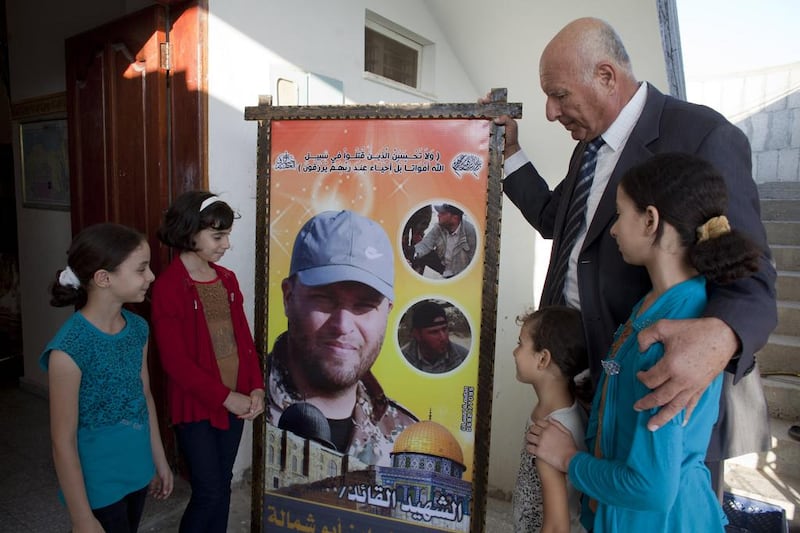KHAN YOUNIS, GAZA STRIP // Militants from Hamas and other groups in Gaza managed to surprise Israel tactically despite being outgunned and outmanned in their latest round of fighting.
Israel said the main objective of its Gaza assault was to destroy the extensive tunnel network developed by the militants to sneak into Israel and to protect and their operational command them from attacks. But the tunnels are only one of the advances made by Hamas and groups such as Islamic Jihad in recent years, analysts say. These advances emulate Lebanon’s Hizbollah movement and its well-organised guerrilla tactics against Israel’s military.
“If we compare what happened in previous military operations in Gaza, it seemed that Hamas – and others – back then was barely able to fight back,” said Itamar Radai, a visiting research fellow at the Tel Aviv-based Institute for National Security Studies.
“This time, however, there was fierce fighting and there were ambushes and booby traps, and it seems they did their homework well. They were much better prepared to confront the Israeli army.”
Those lessons were learnt during Israel’s three-week war on Gaza that began in late December 2008, when its ground troops faced virtually no resistance in the territory.
Analysts said that war, along with an eight-day Israeli air campaign against Gaza in November 2012, demonstrated a need to construct tunnels and bunkers in urban areas to shield fighters, leaders and weapons against Israeli airstrikes. The tunnels also offer an element of surprise against incoming ground troops, and a way to capture soldiers from inside Israel.
More than 60 Israeli soldiers have been killed in this war, which began on July 8, about four times the combined Israeli death toll in 2008-2009 and 2012.
Militant commanders in the territory also began to focus on organising their fighters along the lines of an army, fielding units with distinct expertise in artillery, tunnels and even a marine warfare unit that staged an attack on an Israeli beach early on in this war, said Waleed Modallal, professor of political science at Gaza’s Islamic University.
Commanders also sought to improve coordination between Gaza’s militant groups, which have tended to compete with each other to win financing from foreign backers such as Iran.
“They fight together with the organisation typically associated with armies, not warring factions,” said Mr Modallal.
That organisation was apparently on display during battles in the eastern Gaza areas of Shujaieh on July 19. Facing intense Israeli artillery and airstrikes, fighters used anti-tank missiles against tanks and armoured-personnel carriers. Israel’s military said fighters booby-trapped homes in the area.
An IHS Jane’s Terrorism & Insurgency Centre report this month said, “Hamas appears to be attempting to create the spectre of a continual potential threat to IDF [Israeli military] ground units in Gaza, thereby undermining IDF morale”.
Some estimates put Hamas’s armed wing, the Ezzedine Al Qassam Brigades, at as many as 40,000 fighters, although the group’s extreme secrecy makes verification difficult. Fighters rarely reveal their membership of militant groups for fear of being targeted by Israel.
Fayez Abu Shammala, 63, said he discovered that his son, Hazem, 32, was a fighter in Islamic Jihad only after he was killed by a mortar shell during fighting last month.
“I used to think he was unemployed and I used to argue with him about why he never took a job. I couldn’t understand why he wouldn’t work,” he said.
“Now I know why.”
Some estimates put the number of militant deaths during the past month of fighting at as many as 1,000, although that number is not confirmed. Gaza officials put the total Palestinians death toll at more than 1,900, but say most of them were civilians.
Analysts said a key moment in the development of militant groups in Gaza was Hamas’s takeover of the territory in 2007. That gave the group respite from the Israeli attacks and arrests that its members faced in the occupied West Bank, where Hamas militants gained notoriety for suicide bombings against Israeli civilians during the second Palestinian uprising that began in 2000.
In recent years, Hamas and likeminded factions have been neutralised in the West Bank by security coordination against them by Israel and the Palestinian Authority. But their Gaza stronghold has offered space for training, recruitment and weapons production, including long-range rockets that reached as far north as the Israeli city of Haifa and at least two unmanned aerial vehicles that Hamas attempted to fly over Israel last month.
Akram Atallah, a columnist for the Ramallah-based Al Ayyam newspaper, said Hamas made big strides in terms of training and weapons procurement while Mohammed Morsi was president of Egypt.
A Muslim Brotherhood member and ideological ally of Hamas, Mr Morsi permitted greater leeway for militants from Gaza to travel to places such as Libya, Sudan and elsewhere for training, said Mr Attallah and other analysts.
The group also brought many rockets through the smuggling tunnels between Egypt and Gaza.
“That was very important for the development of the Qassam Brigades,” he said. That proved useful because Hamas had lost support from Iran and Damascus over its refusal to back the regime of president Bashar Al Assad in Syria’s civil war.
But Mr Morsi’s removal from power and the Egyptian military’s destruction of the smuggling tunnels and tightening of the Israeli-imposed siege on Gaza has hindered Hamas’s ability to replenish weapons stocks. That could hamper it in future wars.
Still, a former Hamas fighter, said the group no longer needed foreign support for training. Its fighters had already acquired enough expertise to do so on their own, he said.
“They are ready for the next war.”
foreign.desk@thenational.ae





